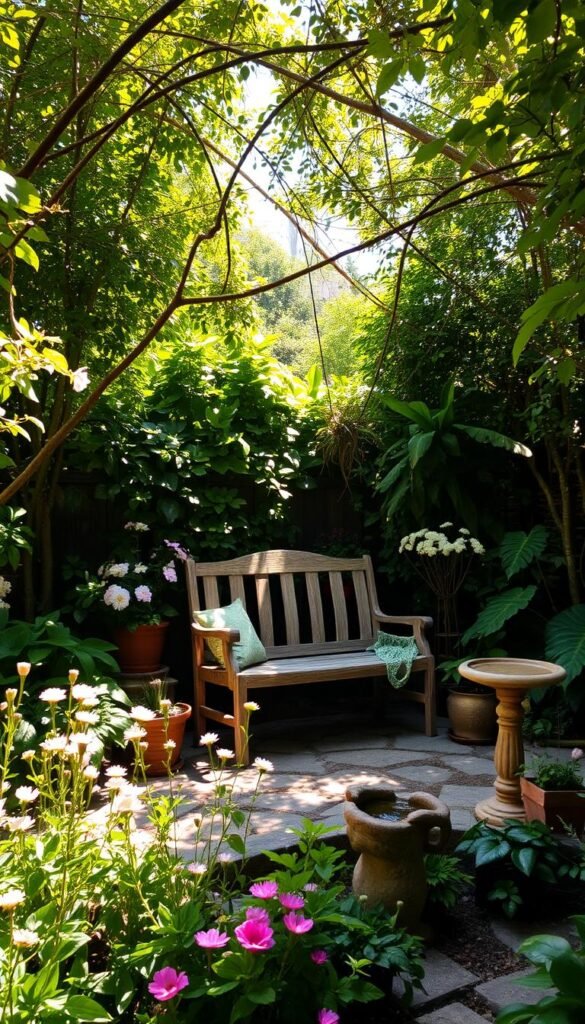Your yard holds untapped potential to become your private escape from daily stress. With thoughtful planning, even small spaces can evolve into calming environments where birdsong replaces notifications and greenery soothes your spirit.
You don’t need professional landscaping skills or endless budgets. Start by noticing what’s already working: mature trees provide shade, flower beds add color, and existing fences create privacy. These elements form your foundation – and save money.
We’ll guide you through design choices that match your lifestyle. Do you crave quiet mornings with coffee? Evenings hosting friends? A yoga nook surrounded by fragrant herbs? Your retreat should reflect what brings you joy.
Simple upgrades make big impacts. Strategic seating arrangements, wind chimes, or container plants can turn underused corners into inviting spots. You’ll learn to balance aesthetics with practicality, creating zones that naturally draw you outside.
Ready to reimagine your connection with nature? Let’s explore how to craft a space where relaxation feels effortless and every season brings new reasons to unwind.
Designing Your Personal Outdoor Oasis
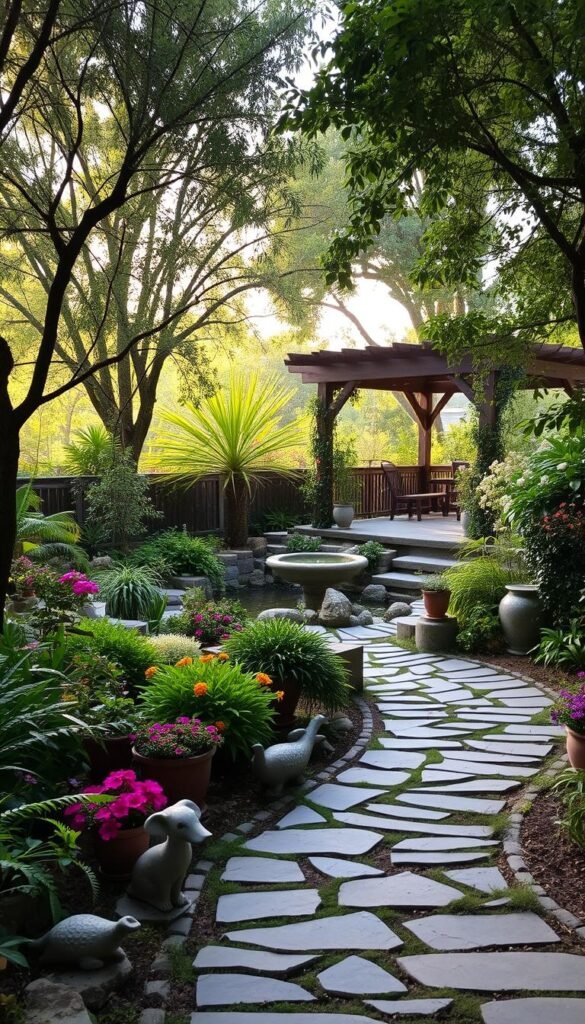
Transforming your yard into a peaceful retreat starts with working smarter, not harder. Before adding new features, take stock of what nature and previous owners have already provided. This approach saves money and creates harmony between your vision and the land’s natural flow.
Assess Your Existing Yard Elements
Walk your space with fresh eyes. Note mature trees that cast cooling shade or flowering shrubs that attract butterflies. Existing fences and trellises offer instant privacy screens, while sunny patches become perfect spots for gardening aesthetic displays. Use this simple checklist:
| Existing Feature | Potential Use | Design Benefit |
|---|---|---|
| Mature trees | Natural canopy for seating | Reduces sun exposure |
| Stone pathways | Guided walkways | Defines zones |
| Sloped areas | Terraced gardens | Adds visual depth |
Define the Purpose of Your Sanctuary
Your backyard should match your daily rhythms. Morning coffee drinkers might prioritize east-facing seating. Yoga enthusiasts need flat, quiet areas. Entertainers require open spaces with durable surfaces. Pro tip: Sketch rough layouts during different times to see how light and noise levels change.
Remember – great design balances beauty and function. By blending existing elements with intentional upgrades, you create a space that feels both curated and completely natural.
Home Garden Ideas for Creating a Personal Outdoor Sanctuary
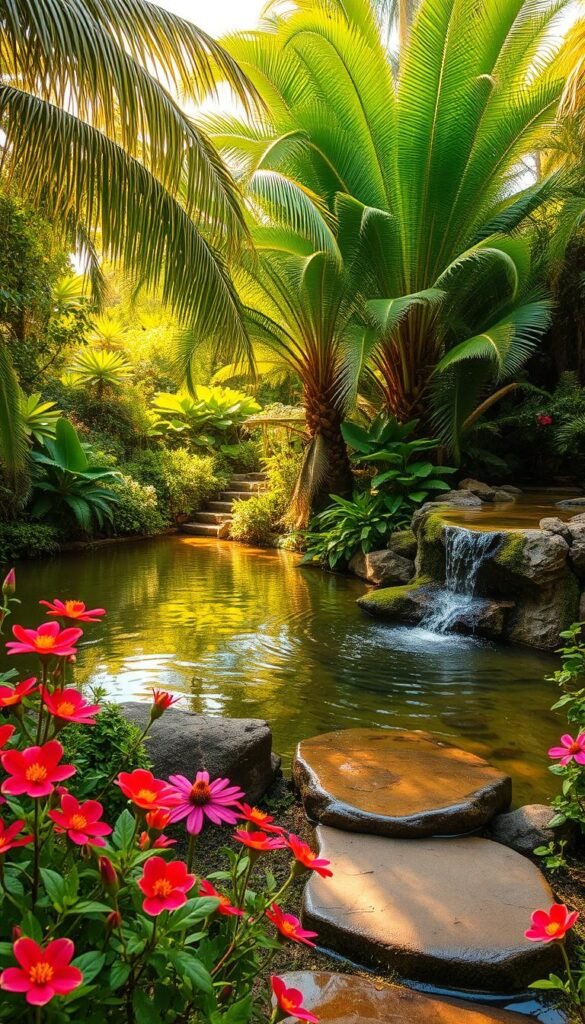
Breathing life into your space starts with embracing nature’s palette. Layer textures and hues through thoughtful plant combinations, then amplify serenity with elements that engage multiple senses.
Incorporate Lush Vegetation and Color
Mix heights and bloom times for year-round interest. Tall ornamental grasses sway behind mid-sized hydrangeas, while creeping thyme spills over stone borders. Pro tip: Use containers to elevate trailing plants like sweet potato vine, creating vertical depth in small areas.
Consider these showstoppers for borders:
| Plant | Seasonal Interest | Maintenance Level |
|---|---|---|
| Japanese Maple | Spring blooms, fall foliage | Low |
| Lavender | Summer flowers, evergreen foliage | Moderate |
| Daylilies | Repeat summer blooms | Easy |
Add Relaxing Water Features and Ambient Lighting
A bubbling stone fountain transforms unused corners into meditation spots. Larger ponds become ecosystems – dragonflies dart above water lilies while frogs nestle in shaded edges. Solar-powered cascades work beautifully in sun-dappled areas.
Twinkle lights woven through trees cast starry patterns after dusk. Combine these with path lighting to guide evening strolls. Remember: LED options last longer and use less energy than traditional bulbs.
Enhancing Comfort and Functionality in Your Backyard
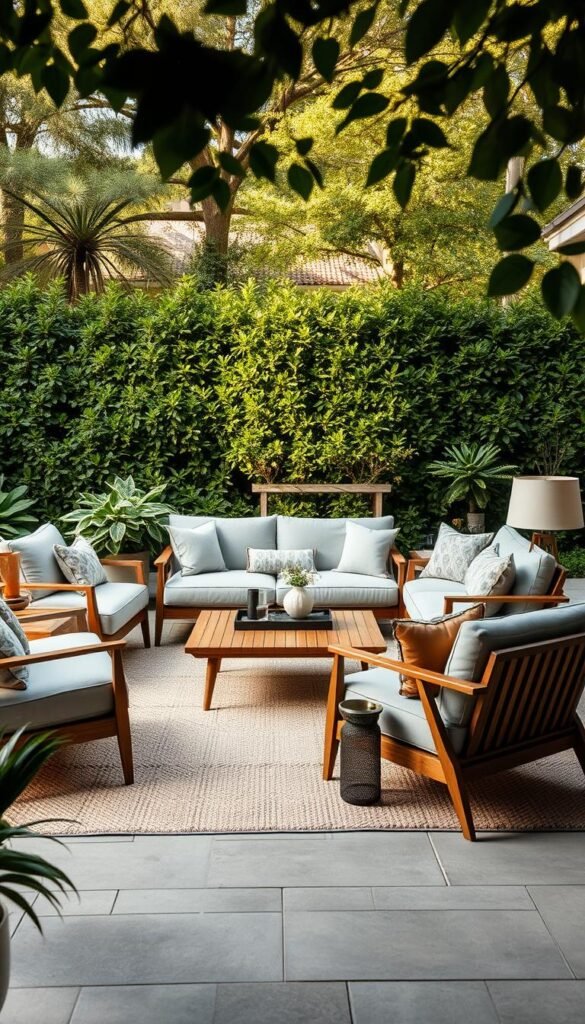
Crafting an inviting backyard begins with pieces that withstand the elements while reflecting your personality. Durable outdoor furniture acts as the backbone of your space, transforming it into a true extension of your home.
Smart Selections for Lasting Enjoyment
Teak and powder-coated metal withstand rain and sun without losing their charm. Wicker offers timeless appeal – pair it with quick-dry cushions for instant comfort. Consider this comparison when choosing materials:
| Material | Lifespan | Care Needs |
|---|---|---|
| Teak | 25+ years | Annual oiling |
| Aluminum | 15+ years | Occasional washing |
| Resin Wicker | 10+ years | Brush debris |
Stone pavers create natural walkways between seating areas. Arrange chaise lounges near flower beds for sunset views, or hang a hammock between mature trees. Pro tip: Outdoor rugs define conversation zones while adding indoor coziness.
Elevate your style by blending weathered accents with contemporary lines. Weather-resistant pillows in earthy tones complete the look, inviting you to linger over morning coffee or stargazing sessions.
Innovative Elements to Elevate Your Garden Design
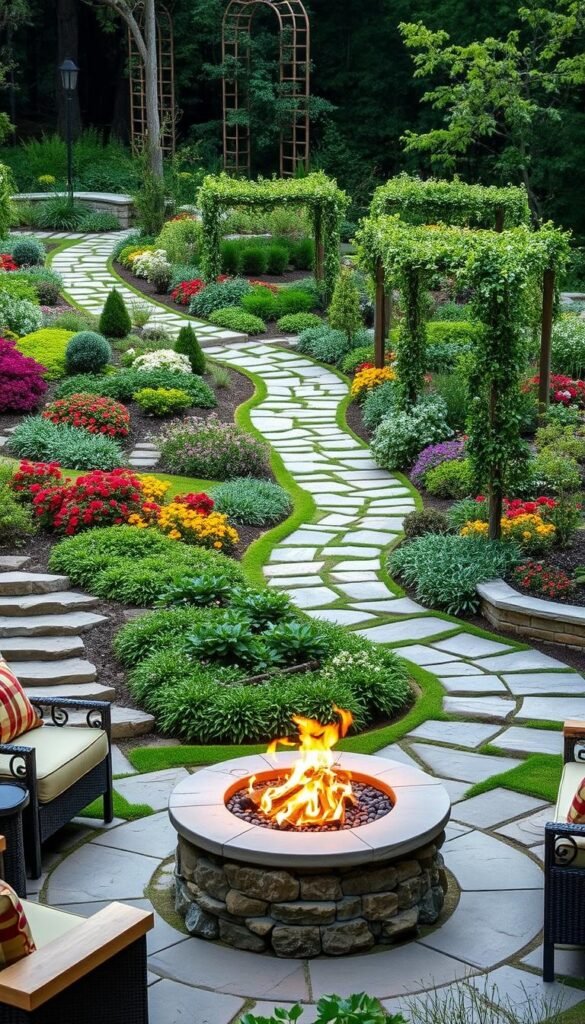
Elevate your outdoor experience with design choices that spark curiosity and comfort. Clever arrangements transform ordinary yards into layered retreats where every turn reveals something delightful.
Utilize Creative Paths, Trellises, and Privacy Screens
Guide exploration with winding paths using gravel, flagstone, or moss-filled stepping stones. These materials soften footsteps while directing attention to hidden seating nooks or fragrant flower beds.
Define borders using vertical elements. A DIY trellises guide helps build structures for climbing roses or morning glories. Pair them with planter boxes on legs for layered greenery that screens neighbors without blocking sunlight.
Introduce Unique Focal Points with Sculptures and Fire Pits
Anchor your design with conversation starters. Weather-resistant sculptures add personality, while wind chimes create soothing soundscapes. For evening magic, position a fire pit where flames reflect nearby water features.
Choose fire pits based on your needs:
- Built-in stone models for permanent gathering spots
- Portable copper bowls for flexible rearrangement
- Gas-powered options for instant ambiance
These features extend outdoor enjoyment into cooler months while providing natural warmth. Watch flickering flames dance against trellis shadows for ultimate relaxation.
Kid-Friendly and Family-Oriented Outdoor Spaces
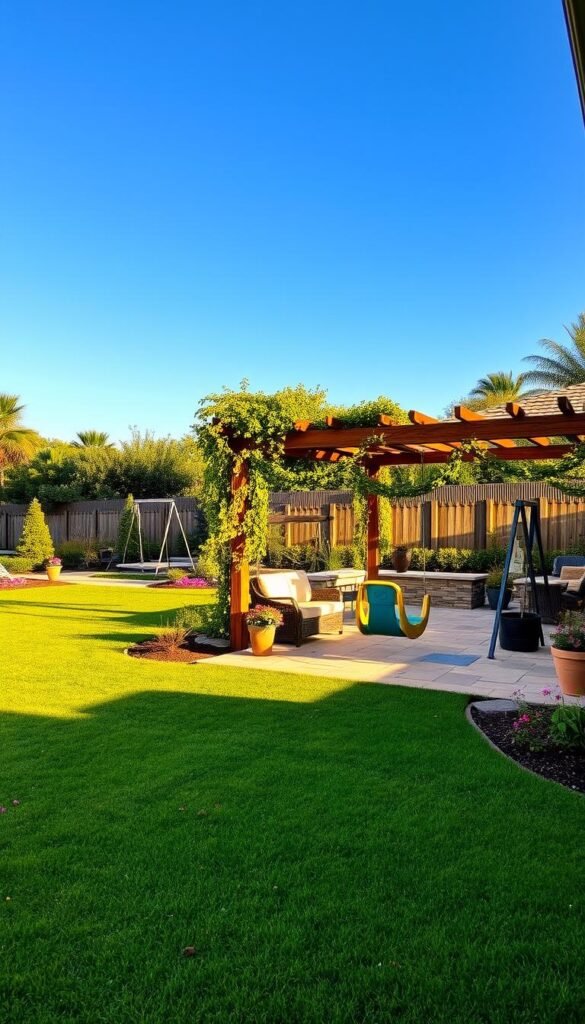
Designing spaces where kids and adults thrive together requires smart planning. Start by mapping zones that balance energy and relaxation – a swing set near seating areas lets parents supervise while sipping lemonade. Safety-first surfaces like rubber mulch or sand cushion falls, letting children explore freely.
Play Zones That Grow With Your Crew
Customize activity areas to match your children’s passions. Active climbers adore cedar play towers with rock walls, while creative minds thrive in sandbox “construction sites.” Use borders like low shrubs to define play boundaries without harsh barriers.
Gathering spots bring everyone together. A circular bench around a tree creates shade for snacks and stories. For larger groups, try family-focused layouts with picnic tables near play equipment – adults chat while kids burn energy.
Choose plants that teach and protect. Native species like milkweed feed butterflies, turning your yard into a living classroom. Avoid thorny roses near play areas, opting instead for soft lamb’s ear leaves that delight tiny fingers.
Mix textures for sensory learning:
- Smooth stepping stones alternating with crunchy gravel
- Wind chimes near bird feeders
- Herb gardens for sniff-and-guess games
These elements create multi-generational appeal while supporting local ecosystems. Your space becomes where scraped knees heal with band-aids and popsicles, and firefly hunts replace screen time.
Final Reflections on Building Your Serene Outdoor Sanctuary
Now that your retreat takes shape, it becomes more than arranged plants and seating – it’s where fresh air revives your spirit. Thoughtful lighting transforms ordinary evenings, with solar-powered options casting soft glows along paths. Combine string lights for ambiance and focused fixtures for grilling areas to balance beauty with practicality.
Your vegetable patch serves dual purposes: crisp snacks and grounding moments tending earth. Nearby, the fire pit’s crackle draws friends through autumn nights while reflecting flames dance in water features. These elements merge function with calm, creating spaces where time slows naturally.
Consider adding Zen-inspired elements like raked gravel or wind chimes to deepen tranquility. Solar lamps near steps ensure safety without harsh glare, letting moonlight dominate. Every choice – from plant textures to seating angles – should whisper “stay awhile” in your personal oasis.
As seasons shift, your sanctuary adapts. Spring blooms perfume morning coffee spots, while summer shade shelters afternoon reads. This living extension of home grows richer with each memory made – proof that nurturing nature rewards you daily.

